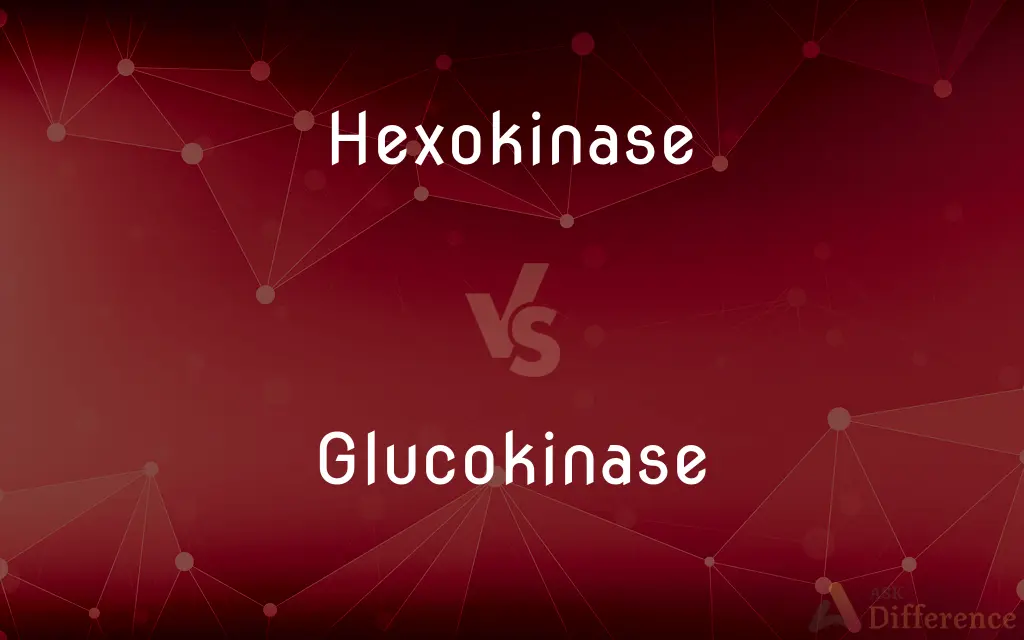Hexokinase vs. Glucokinase — What's the Difference?
By Fiza Rafique & Maham Liaqat — Updated on April 5, 2024
Hexokinase catalyzes the phosphorylation of glucose to glucose-6-phosphate in all cells, with broad substrate specificity, whereas glucokinase, a type of hexokinase found in liver and pancreatic β-cells, has high specificity for glucose.

Difference Between Hexokinase and Glucokinase
Table of Contents
ADVERTISEMENT
Key Differences
Hexokinase is an enzyme present in nearly all cells that catalyzes the first step in glucose metabolism, the conversion of glucose to glucose-6-phosphate. This reaction is crucial for cellular energy production. Glucokinase, on the other hand, is a specific form of hexokinase found predominantly in the liver and pancreatic β-cells, playing a key role in regulating blood glucose levels and insulin release.
While hexokinase has a low Km value, indicating a high affinity for glucose even at low concentrations, glucokinase has a high Km value, meaning it is active only at higher glucose concentrations, making it effective in regulating glucose levels in the blood. This difference underscores hexokinase's role in general glucose metabolism across tissues, whereas glucokinase acts as a glucose sensor, particularly in the liver.
Hexokinase is inhibited by its product, glucose-6-phosphate, ensuring that it does not overconsume glucose when it is not needed for energy production. Conversely, glucokinase is not inhibited by glucose-6-phosphate, allowing the liver to continue glucose uptake and conversion, contributing to blood glucose homeostasis.
The activity of glucokinase is regulated by glucokinase regulatory protein (GKRP) in the liver, which modulates its activity in response to glucose and other metabolic signals. Hexokinase does not interact with GKRP, highlighting a regulatory mechanism specific to glucokinase that aligns with its role in glucose sensing and metabolic regulation.
Hexokinase operates efficiently in a wide range of glucose concentrations, ensuring that glucose is readily phosphorylated for metabolism or storage. Glucokinase, due to its role in the liver, acts more selectively, primarily engaging in glucose metabolism when glucose is abundant, thus participating in maintaining glucose homeostasis and energy storage.
ADVERTISEMENT
Comparison Chart
Location
All cells
Liver and pancreatic β-cells
Km Value
Low (high affinity for glucose)
High (lower affinity, active at high glucose levels)
Regulation
Inhibited by glucose-6-phosphate
Regulated by glucose levels and GKRP
Function
Catalyzes glucose phosphorylation universally for energy production
Acts as a glucose sensor, regulating blood glucose and insulin release
Substrate Specificity
Broad, can phosphorylate other hexoses
High specificity for glucose
Compare with Definitions
Hexokinase
An enzyme that phosphorylates glucose to form glucose-6-phosphate, initiating glycolysis.
Hexokinase activity is crucial for tissues with high energy demands, such as muscles and the brain.
Glucokinase
Has a high Km value, making it responsive to high glucose concentrations.
This characteristic allows glucokinase to act as a glucose sensor in the liver.
Hexokinase
Present in almost all organisms, reflecting its fundamental role in glucose metabolism.
Hexokinase mutations can significantly impact cellular energy production.
Glucokinase
Not inhibited by glucose-6-phosphate, facilitating glucose uptake during hyperglycemia.
Glucokinase activity helps in regulating blood glucose levels.
Hexokinase
Characterized by a low Km value, indicating high affinity for glucose.
This property allows hexokinase to function efficiently even when glucose levels are low.
Glucokinase
Specific to glucose, underscoring its role in glucose sensing and insulin release.
Glucokinase's specificity is critical for its function in glucose homeostasis.
Hexokinase
Inhibited by its product, ensuring regulated glucose uptake.
This feedback mechanism prevents excessive glucose consumption in cells.
Glucokinase
A liver and pancreatic enzyme that phosphorylates glucose when blood levels are high.
Glucokinase plays a key role in liver glucose metabolism and energy storage.
Hexokinase
Universal in its action across different tissues, highlighting its essential role.
Hexokinase ensures that glucose is readily phosphorylated for metabolism or storage.
Glucokinase
Regulated by glucokinase regulatory protein, linking it to metabolic needs.
This regulation ensures that glucokinase activity aligns with the body's overall metabolic state.
Hexokinase
A hexokinase is an enzyme that phosphorylates hexoses (six-carbon sugars), forming hexose phosphate. In most organisms, glucose is the most important substrate for hexokinases, and glucose-6-phosphate is the most important product.
Glucokinase
Glucokinase (EC 2.7.1.2) is an enzyme that facilitates phosphorylation of glucose to glucose-6-phosphate. Glucokinase occurs in cells in the liver and pancreas of humans and most other vertebrates.
Hexokinase
(enzyme) Any enzyme that catalyses the phosphorylation of a hexose
Glucokinase
A hexokinase isozyme that facilitates phosphorylation of glucose to glucose-6-phosphate, occurring in cells in the liver, pancreas, gut, and brain of humans and most other vertebrates.
Hexokinase
An enzyme catalyzing the transfer of a phosphate residue from ATP to a hexose, as in the formation of glucose-6-phosphate from glucose.
Common Curiosities
Why is glucokinase important in the liver?
Glucokinase acts as a glucose sensor in the liver, regulating glucose uptake and conversion, contributing to blood glucose homeostasis and insulin release.
Can hexokinase act on other sugars besides glucose?
Yes, hexokinase has broad substrate specificity and can phosphorylate other hexoses besides glucose.
What regulates hexokinase and glucokinase activity?
Hexokinase is regulated by its product, glucose-6-phosphate, whereas glucokinase is regulated by glucose levels and glucokinase regulatory protein (GKRP).
How does glucokinase differ from hexokinase?
Glucokinase is a specific form of hexokinase found in liver and pancreatic β-cells, with high specificity for glucose and regulation by glucose levels, unlike hexokinase, which has broad substrate specificity and is found in all cells.
Is glucokinase found in muscle cells?
No, glucokinase is primarily found in the liver and pancreatic β-cells, not in muscle cells.
Are there any inhibitors of hexokinase?
Yes, glucose-6-phosphate is a natural inhibitor of hexokinase, regulating its activity in cells.
How does the Km value affect hexokinase and glucokinase function?
The low Km value of hexokinase means it has a high affinity for glucose at low concentrations, ensuring glucose phosphorylation under various conditions. Glucokinase's high Km value means it's active at higher glucose levels, suitable for its role in glucose regulation.
What is the significance of glucokinase in insulin secretion?
Glucokinase acts as a regulator of insulin secretion in pancreatic β-cells by responding to high glucose levels, linking glucose metabolism to insulin release.
What is hexokinase?
Hexokinase is an enzyme that catalyzes the phosphorylation of glucose to glucose-6-phosphate, a critical step in glucose metabolism present in nearly all cells.
Can glucokinase deficiency affect health?
Yes, glucokinase deficiency can lead to an inability to regulate blood glucose levels properly, contributing to conditions like maturity-onset diabetes of the young (MODY).
What role does glucokinase play in diabetes?
Glucokinase's role in regulating blood glucose and insulin release makes it a key enzyme in understanding and managing diabetes, especially type 2.
What happens if hexokinase is deficient?
A deficiency in hexokinase can lead to impaired glucose metabolism, affecting energy production in cells and potentially resulting in metabolic disorders.
How is glucokinase activity measured?
Glucokinase activity can be measured in liver or pancreatic tissue samples through biochemical assays that quantify its ability to phosphorylate glucose.
Can the activity of glucokinase be enhanced or inhibited for therapeutic purposes?
Yes, modulating glucokinase activity through activators or inhibitors is a potential therapeutic approach for managing blood glucose levels in diabetes.
How does glucokinase contribute to glucose homeostasis?
Glucokinase contributes to glucose homeostasis by regulating the rate of glucose phosphorylation in the liver, according to the body's metabolic needs and blood glucose levels.
Share Your Discovery

Previous Comparison
Geometry vs. Trigonometry
Next Comparison
Economics vs. CommerceAuthor Spotlight
Written by
Fiza RafiqueFiza Rafique is a skilled content writer at AskDifference.com, where she meticulously refines and enhances written pieces. Drawing from her vast editorial expertise, Fiza ensures clarity, accuracy, and precision in every article. Passionate about language, she continually seeks to elevate the quality of content for readers worldwide.
Co-written by
Maham Liaqat














































